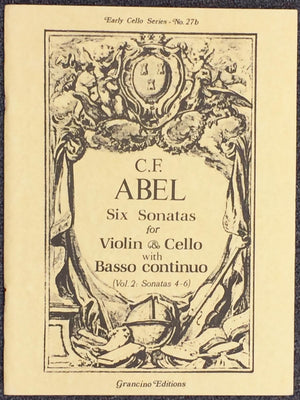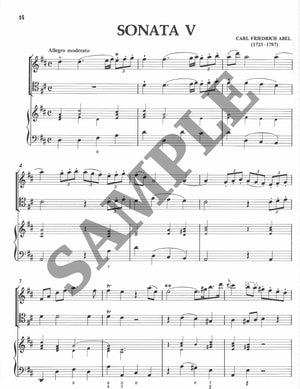Your Cart is Empty






Six Sonatas for Violin and Cello with Basso continuo (Vol. 2: Sonatas 4-6) - Cello Music
$24.00
Selecting Shipping: USPS Ground Advantage is
slow and unreliable for tracking, and sometimes takes an unexpected world tour before arriving at your house! If you need something fast, please use USPS Priority, or UPS.
Part of the Grancino Series, edited by cellist Nona Pyron, Abel was a peer of J.C. Bach and noted for his virtuosity on the viola de gamba and cello.
About the Composer
Carl Friedrich Abel, born at Cöthen on 22nd December 1723, was the last of the great virtuosi on the viola da gamba. In 1748 he joined the Dresden court orchestra, but decided on a solo career and moved to London in 1759. His performances on the gamba and harpsichord soon earned him respect and admiration as well as the patronage of the Duke of York, and subsequently, Queen Charlotte. When J. C. Bach arrived in London, Abel joined him in promoting a series of concerts that mainly featured their own compositions. Beginning at the Vauxhall Gardens, they soon sought a more exclusive milieu for their joint venture, and this was provided by the singer and courtesan Theresa Cornelys, whose light-hearted and somewhat indecorous entertainments at Carlisle House in Soho Square at once took on a more elegant and serious tone. After Bach's death in 1782 Abel tried to continue the series, but gave up and went back to Germany for 2 years. On his return to London in 1785, he was welcomed into new concert-giving organizations and performed with them until a month before his death on 20th June, 1787. A friend of Gainsborough and Goethe, Abel made a lasting contribution to music in his symphonies, concertos, and chamber music, and was also the teacher of singers, violinists, and cellists. ~Denis Stevens
About These Trios
Although famous as a viola de gamba virtuoso, Abel also played the cello. To cellists he is perhaps best known as the performer for whom, in the opinion of some historians, J.S. Bach wrote the Six Solo Suites. Certainly his pairing of the cello with the violin in these trios shows a familiarity with the instrument.
The trios were written in London in 1772 and were "Printed for the Author & sold at his House No. 210 Oxford Street" - a practice not uncommon in the mid-18th century. In style they bespeak the elegance and gentility of the musical society both Abel and J.C. Bach had grown to know in London. While not technically demanding, they are musically extremely gratifying to play and and exemplify the highly cultured state of chamber music in England at this time. As was no doubt their aim, they provide pleasure to performers and listeners alike.
The "Sonatas" (we would call them "Trio Sonata") are quite brief, each consisting of two movements which contrast in mood and tempo, the second movement always being some form of dance movement. ~Nona Pyron, Series Editor
Note: Includes full score and all parts
Got a Question?
Send us a Message
If you have a question about this product, or anything else for that matter, please send us a message and we'll get back to you right away!
If you would like to speak to one of us on the phone, please include your number in the message and one of us will call you back as soon as we are able.












